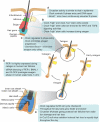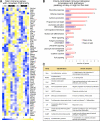The circadian clock in skin: implications for adult stem cells, tissue regeneration, cancer, aging, and immunity
- PMID: 25589491
- PMCID: PMC4441597
- DOI: 10.1177/0748730414563537
The circadian clock in skin: implications for adult stem cells, tissue regeneration, cancer, aging, and immunity
Abstract
Historically, work on peripheral circadian clocks has been focused on organs and tissues that have prominent metabolic functions, such as the liver, fat, and muscle. In recent years, skin has emerged as a model for studying circadian clock regulation of cell proliferation, stem cell functions, tissue regeneration, aging, and carcinogenesis. Morphologically, skin is complex, containing multiple cell types and structures, and there is evidence for a functional circadian clock in most, if not all, of its cell types. Despite the complexity, skin stem cell populations are well defined, experimentally tractable, and exhibit prominent daily cell proliferation cycles. Hair follicle stem cells also participate in recurrent, long-lasting cycles of regeneration: the hair growth cycles. Among other advantages of skin is a broad repertoire of available genetic tools enabling the creation of cell type-specific circadian mutants. Also, due to the accessibility of skin, in vivo imaging techniques can be readily applied to study the circadian clock and its outputs in real time, even at the single-cell level. Skin provides the first line of defense against many environmental and stress factors that exhibit dramatic diurnal variations such as solar ultraviolet (UV) radiation and temperature. Studies have already linked the circadian clock to the control of UVB-induced DNA damage and skin cancers. Due to the important role that skin plays in the defense against microorganisms, it also represents a promising model system to further explore the role of the clock in the regulation of the body's immune functions. To that end, recent studies have already linked the circadian clock to psoriasis, one of the most common immune-mediated skin disorders. Skin also provides opportunities to interrogate the clock regulation of tissue metabolism in the context of stem cells and regeneration. Furthermore, many animal species feature prominent seasonal hair molt cycles, offering an attractive model for investigating the role of the clock in seasonal organismal behaviors.
Keywords: UV exposure; aging; autoimmune diseases; cancer; cell cycle; hair follicle; immunity; regeneration; skin; stem cells.
© 2015 The Author(s).
Figures




Similar articles
-
Circadian clocks: from stem cells to tissue homeostasis and regeneration.EMBO Rep. 2018 Jan;19(1):18-28. doi: 10.15252/embr.201745130. Epub 2017 Dec 19. EMBO Rep. 2018. PMID: 29258993 Free PMC article. Review.
-
The Impact of the Circadian Clock on Skin Physiology and Cancer Development.Int J Mol Sci. 2021 Jun 6;22(11):6112. doi: 10.3390/ijms22116112. Int J Mol Sci. 2021. PMID: 34204077 Free PMC article. Review.
-
Therapeutic implications of the circadian clock on skin function.J Drugs Dermatol. 2014 Feb;13(2):130-4. J Drugs Dermatol. 2014. PMID: 24509961
-
Human long-term deregulated circadian rhythm alters regenerative properties of skin and hair precursor cells.Eur J Dermatol. 2018 Aug 1;28(4):467-475. doi: 10.1684/ejd.2018.3358. Eur J Dermatol. 2018. PMID: 30396867
-
Overview of the Circadian Clock in the Hair Follicle Cycle.Biomolecules. 2023 Jul 3;13(7):1068. doi: 10.3390/biom13071068. Biomolecules. 2023. PMID: 37509104 Free PMC article. Review.
Cited by
-
The Influence of Circadian Rhythms on DNA Damage Repair in Skin Photoaging.Int J Mol Sci. 2024 Oct 11;25(20):10926. doi: 10.3390/ijms252010926. Int J Mol Sci. 2024. PMID: 39456709 Free PMC article. Review.
-
Infrared-A to improve mood: an exploratory study of water-filtered infrared-A (wIRA) exposure.Photochem Photobiol Sci. 2024 Oct 23. doi: 10.1007/s43630-024-00650-2. Online ahead of print. Photochem Photobiol Sci. 2024. PMID: 39441451
-
Analysis of Circadian Clock Gene Expression in Human Skin Explants.JID Innov. 2024 Aug 23;4(6):100308. doi: 10.1016/j.xjidi.2024.100308. eCollection 2024 Nov. JID Innov. 2024. PMID: 39314650 Free PMC article.
-
Changes in Cells Associated with Insulin Resistance.Int J Mol Sci. 2024 Feb 18;25(4):2397. doi: 10.3390/ijms25042397. Int J Mol Sci. 2024. PMID: 38397072 Free PMC article. Review.
-
The Opioid Receptor Influences Circadian Rhythms in Human Keratinocytes through the β-Arrestin Pathway.Cells. 2024 Jan 25;13(3):232. doi: 10.3390/cells13030232. Cells. 2024. PMID: 38334624 Free PMC article.
References
-
- Abe T, Sakaue-Sawano A, Kiyonari H, Shioi G, Inoue K, Horiuchi T, Nakao K, Miyawaki A, Aizawa S, Fujimori T. Visualization of cell cycle in mouse embryos with Fucci2 reporter directed by Rosa26 promoter. Development. 2013;140:237–246. - PubMed
-
- Akashi M, Soma H, Yamamoto T, Tsugitomi A, Yamashita S, Yamamoto T, Nishida E, Yasuda A, Liao JK, Node K. Noninvasive method for assessing the human circadian clock using hair follicle cells. Proceedings of the National Academy of Sciences of the United States of America. 2010;107:15643–15648. - PMC - PubMed
-
- Al-Nuaimi Y, Hardman JA, Biro T, Haslam IS, Philpott MP, Toth BI, Farjo N, Farjo B, Baier G, Watson RE, Grimaldi B, Kloepper JE, Paus R. A meeting of two chronobiological systems: circadian proteins Period1 and BMAL1 modulate the human hair cycle clock. The Journal of investigative dermatology. 2014;134:610–619. - PubMed
Publication types
MeSH terms
Grants and funding
LinkOut - more resources
Full Text Sources
Other Literature Sources
Medical

